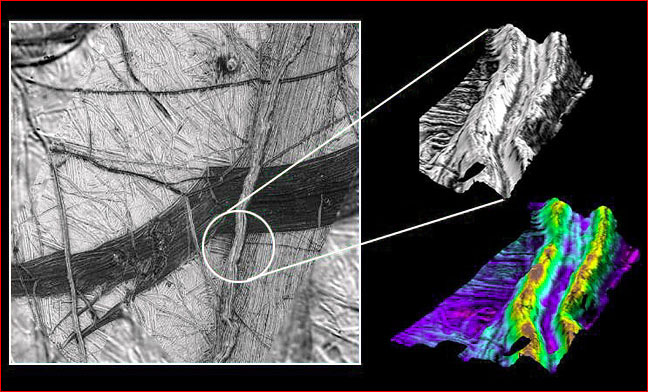
home •
about •
essential guide •
picture of the day •
thunderblogs •
news •
multimedia •
predictions •
products •
get involved •
contact

Credit: NASA/JPL/Galileo imaging team
pic of the day
archive
subject index
abstract
archive
Links:
Society for
Interdisciplinary
Studies
Mar 15, 2005
Best Picture of a Europan Rille
Context and analysis of a rope-like furrow on Jupiter’s moon Europa suggests a lightning trench, not a “fracture” of an ice sheet.
For proponents of the Electric Universe, the Jovian moon Europa provides more than one example of what has gone wrong in the theoretical sciences. Discoveries in space almost never fulfill the predictions of the prevailing models. Popular theoretical frameworks in cosmology, astrophysics, geology, and planetary science are rooted in thinking prior to the space age, and those formulating these approaches lacked a knowledge of plasma science, particularly the study of plasma discharge.
The picture above is from a relatively small region on Europa at about 16 degrees south latitude, 195 degrees west longitude. It was imaged on November 6th, 1996 and shows a surface entirely covered by filamentary, rope-like and “paintbrush” imprints. Theorists of the “Electric Universe” are aghast at the tenacity with which NASA’s investigators have held to the interpretation of these parallel grooves and furrows as “cracks” in the ice, a theory maintained in the absence of any evidence that ice fracturing could generate such patterns. (See “Europa—Dynamics of Rille Formation”
The inset in the picture above presents a section of the rope-like surface imprint, in three-dimensional perspective. The picture combines high resolution images obtained from two different viewing angles, creating a scene in much the same way that our brains construct an image when both eyes view something from two angles. The resulting picture has a resolution of 26 meters per picture element. It does not show a crack in the ice. Rather, it shows what appears to be an explosively cut furrow, with levees or ridges on both sides reaching up to 300 meters (red) in height above the surroundings (purple). The two ridges are separated by a valley about 1.5 kilometer wide.
In the electric model, the material excavated from the trench can be accounted for by that found in the levees. Of course, this is not what we should expect from repeated opening, closing, and compression upwards of slushy material from a crack in the ice. From the electric viewpoint, the furrow should be compared to the V-shaped form of lightning trenches. This model envisions a traveling underground discharge explosively excavating the loose material in the ridges. Then the melted ice along the heated lightning track at the base of the furrow relaxes back to a level close to that of the surrounding surface.
Of course the phrase “lightning-carved furrows” has no place in the lexicon of official planetary science today. And so the conventional picture of Europa is constituted almost entirely of paradoxes, contradictions, and unanswered questions.
For context of this “Picture of the Day”, See: Europa—Caught in the Middle
EXECUTIVE EDITORS:
David Talbott, Wallace Thornhill
MANAGING EDITOR: Amy Acheson
CONTRIBUTING EDITORS: Mel Acheson, Michael Armstrong, Dwardu Cardona,
Ev Cochrane, C.J. Ransom, Don Scott, Rens van der Sluijs, Ian Tresman
WEBMASTER: Michael Armstrong
Copyright 2005: thunderbolts.info